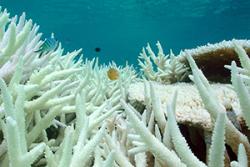Reefs that experience high frequency temperature variability most likely to resist coral bleaching
 Bleached corals: Image credit & copyright Paul MarshallAs scientists and conservationists race to work out the best way to conserve the world’s coral reefs, a new study reveals why some reefs appear to be more resistant to coral bleaching during ocean warming events and calls for higher-resolution data to be collected.
Bleached corals: Image credit & copyright Paul MarshallAs scientists and conservationists race to work out the best way to conserve the world’s coral reefs, a new study reveals why some reefs appear to be more resistant to coral bleaching during ocean warming events and calls for higher-resolution data to be collected.
The authors, from a number of American Universities and Bangor University in the UK, writing in Nature Communications utilise data collected from 118 coral reef locations globally. They illustrate how reefs over very small distances - as little as tens or hundreds of meters of each other, can be subject to different daily sea temperature changes - based on their depth and their position on the reef. These reefs end up having different fates during ocean warming events. Reefs subjected to high sea temperature fluctuations on daily or tidal timescales leading up to the ocean warming event are better able to resist coral bleaching, such that a 1⁰C increase in daily temperature range reduces the odds of more severe bleaching by a factor of 33.
In the short term, this information helps to explain the patchy distribution of coral bleaching across reefs during thermal stress events. In the long term, the information helps to identify reefs that may have a greater potential for resisting thermal stress, information that can help guide marine spatial planning and conservation targets and priorities.
 A healthy coral reef.: Image credit & Copyright: Brian Zgliczynski“Rising ocean temperatures and ocean warming events driven by global climate change represent the greatest current threat to the integrity of coral reef ecosystems worldwide” says co-author Gareth Williams of Bangor University’s School of Ocean Sciences. “These warming events have become more frequent and are projected to keep increasing in frequency in the coming decades” says Williams.
A healthy coral reef.: Image credit & Copyright: Brian Zgliczynski“Rising ocean temperatures and ocean warming events driven by global climate change represent the greatest current threat to the integrity of coral reef ecosystems worldwide” says co-author Gareth Williams of Bangor University’s School of Ocean Sciences. “These warming events have become more frequent and are projected to keep increasing in frequency in the coming decades” says Williams.
Coral reefs represent one of the most diverse ecosystems on our planet, providing essential ecosystem services, like fisheries and shoreline protection, to millions of people.
“It is vital we identify the mechanisms behind the apparent resistance to bleaching on some reefs” says Williams. “Importantly, our results show that the resistance of corals to bleaching in areas of high-frequency temperature variability occurs in reef regions throughout the world. This positive news should not distract from the urgent need to reduce greenhouse gas emissions to protect coral reefs globally, but instead help guide strategic management actions in the inevitable interim.”
Publication date: 30 April 2018
